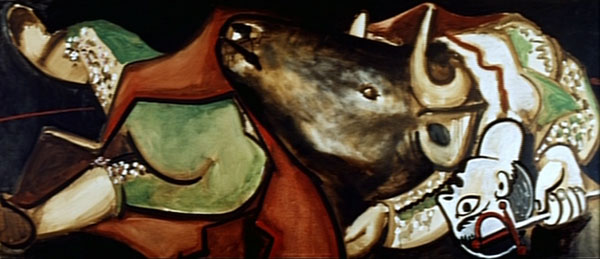After watching Henri-Georges Clouzot’s Inferno, which documents the director’s experiments with visual effects and attempts to integrate them with his stories via dream sequences, then reading at the end that he later used all these effects in The Prisoner, what could I do but run straight out to watch The Prisoner.

And boy did he ever put those effect experiments to use. It is full of light and color and lines and boxes, reflections and refractions. Real tight framing and editing, very clockwork in a wonderful way, with outstanding music, acting that seems unexceptional at first, but gets better. I’ve liked all the Clouzot movies I’ve seen, but have heard nothing about this one, so figured it’d be a dull late-career entry (it was his final released film), but no, he went out with a bang.

Gilbert (Bernard Fresson of Z and Street of No Return) is an artist who specializes in mass-produceable objects with geometric patterns that cause optical illusions when you spin them round. Stan (Laurent Terzieff of The Milky Way) runs a gallery where Gil and other guys are putting on a show. And Josée (Elisabeth Wiener of Duelle) is Gil’s girl, who jealously spies her man Gil talking to a reporter in a hall of mirrors, and so strikes up a chat with leering Stan, going back to his place to look at photos of “handwriting”.


The only thing I remember of Josée’s day job is that she spends some hours looking at interview films on an editing table, commenting that she can’t understand submissiveness and masochism in women. Of course this is a setup, and when she’s at Stan’s place she “accidentally” spies a slide of a naked girl in chains, which fascinates and excites her. Oh of course, it’s just another thing Stan dabbles in, photographing nude bondage sessions, but Josée is now obsessed, insists on attending the next one. Maguy (Dany Carrel, returning from Inferno) poses, Stan photographs and Josée watches anxiously.


Josée soon agrees to be photographed herself, and starts a heated affair with Stan. This was one year after Belle de Jour (and given Clouzot’s pacing, he might have written this film before Buñuel even dreamed of his). Clouzot’s picture is both less and more extreme than Buñuel’s – it’s surely more passionate and less clinical, when considering two directors I would’ve expected the opposite. The photographic sessions, even Maguy’s first one with minimal nudity, are erotic as hell, the height of sexy editing. It may be ultimately more tame than Belle de Jour though, with overall less to say about societal norms and sexuality.
Husband vs. lover, splendidly shot through a half-reflecting window:

Stan has a more poetic penchant for suicide than did the desperate, more tragic Dominique in La Vérité:

Interesting to watch this in the same month as Lady of Burlesque (1943), From Here to Eternity (1953), Monika (1953 but released in the U.S. in ’56), The Apartment (1960), Knife in the Water (1962) and even The Girlfriend Experience (2009). Half were (or at least were intended to be) sexually progressive films when released, all seem very of-their-time, and only The Apartment and this one still seem capable of shocking anyone today.

I loved the camerawork – mobile, but always with a specific goal, a plan to paint a picture through time. Clouzot, 60 years old, a widower with heart trouble, doesn’t seem quite up to the task of smashing a complacent society and visual expectations to bits with his camera, but he has no trouble smashing his lead actress to bits with a train, something he attempted earlier in Inferno.

D. Cairns:
And as a final note of strangeness, the film ends with a woman in a hospital bed calling for the wrong man—the very same ending as Richard Lester’s seminal Petulia, released the very same year. No possibility of one film influencing the other. Instead, both films must be hooked into something, something out there in the ether. Cinema can do that.































